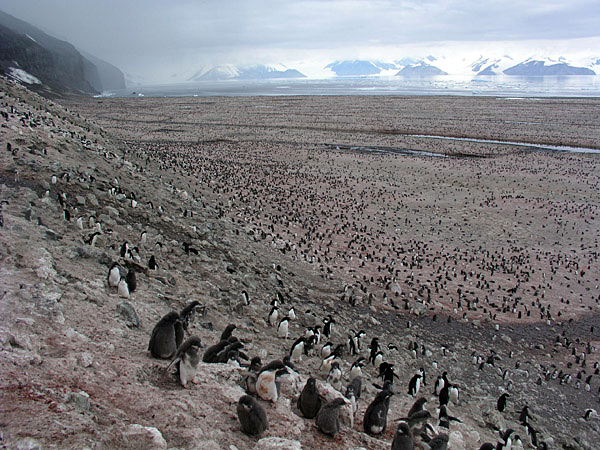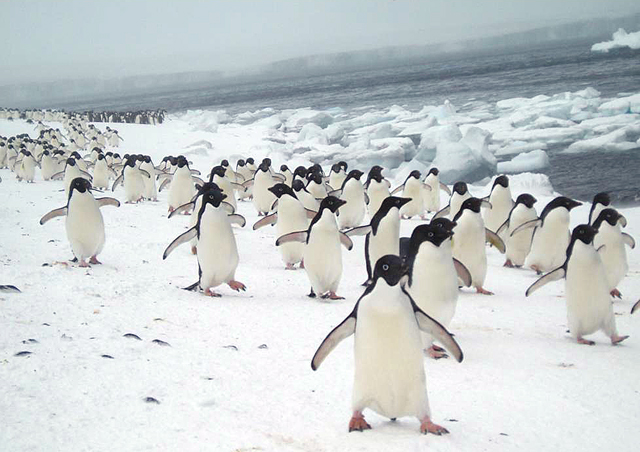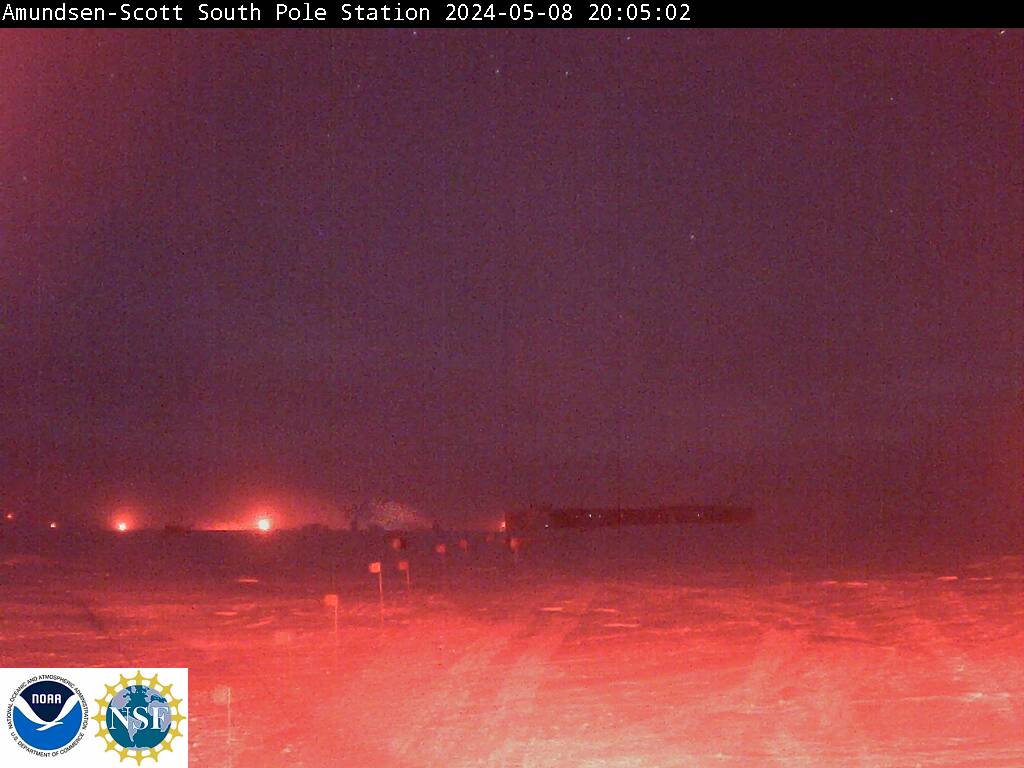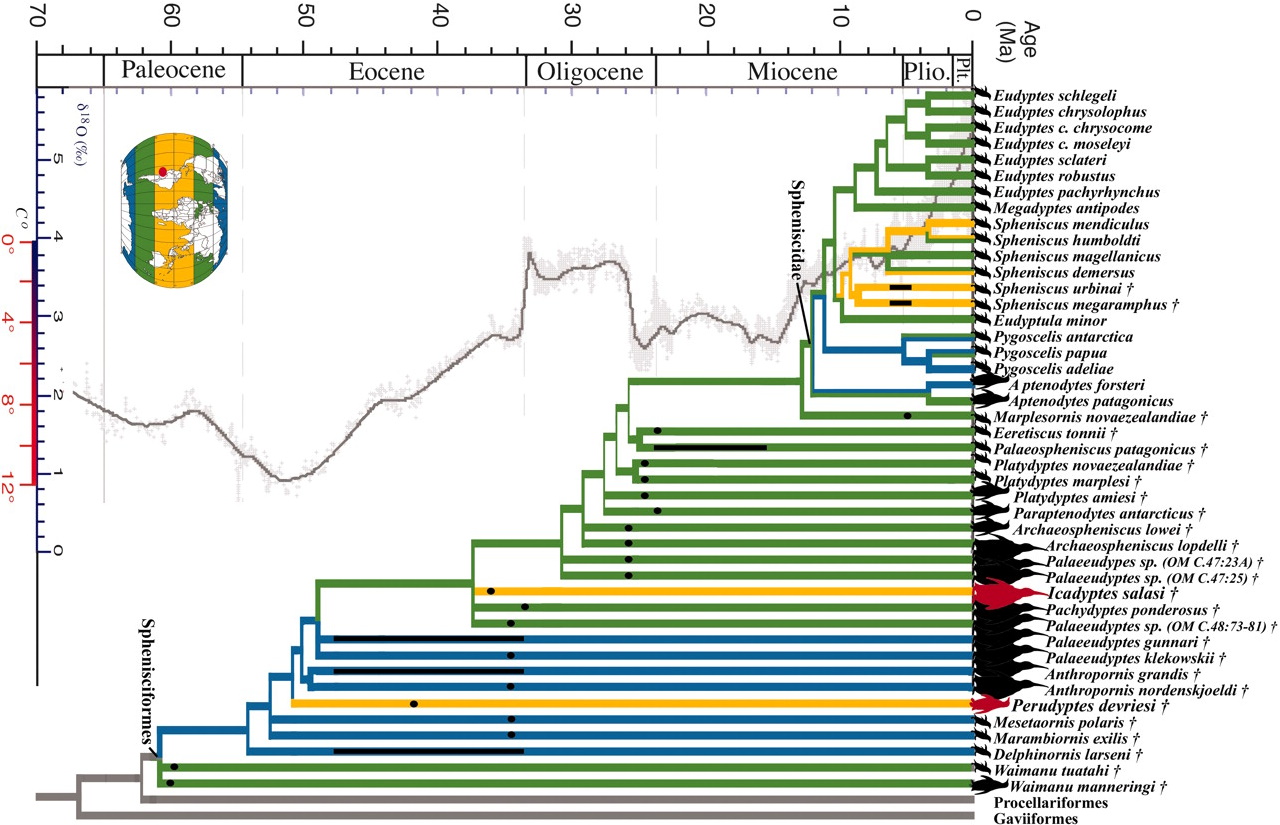 Cape Adare is home to the largest Adélie penguin colony in Antarctica. Until about 200 years ago, when humans decimated whale and seal populations, the penguins subsisted mainly on fish. But the ensuing surplus of krill created by the dearth of top predators caused a shift in diet. Photo Credit: Steve Emslie
Cape Adare is home to the largest Adélie penguin colony in Antarctica. Until about 200 years ago, when humans decimated whale and seal populations, the penguins subsisted mainly on fish. But the ensuing surplus of krill created by the dearth of top predators caused a shift in diet. Photo Credit: Steve Emslie Photo Credit: Michael Polito
Photo Credit: Michael PolitoAdélie penguins march along Brown Bluff at the northern end of the Antarctic Peninsula.
Changing diet
Krill surplus 200 years ago may have caused penguins to shift prey preferences
By Peter Rejcek, Antarctic Sun Editor
Posted October 30, 2009
Most of us have heard the oft-repeated phrase, “You are what you eat.” Turns out it’s not just a way for your mother to nag you about your poor eating habits.
By studying the tissue remains of penguins in Antarctica, scientists are not only learning more about the modern diet of the continent’s iconic seabird but also what was on the menu thousands of years ago. And that information can provide insight into past climate and penguin behavior, as well as how the species could respond to future climate changes.
Steve Emslie External Non-U.S. government site, a marine ornithologist in the Department of Biology and Marine Biology External Non-U.S. government site at the University of North Carolina Wilmington External Non-U.S. government site, and his team are in the midst of a five-year grant from the National Science Foundation (NSF) External U.S. government site to determine how changes in climate and penguin prey dynamics have influenced the seabird population.
Much of their work involves collecting tissue samples, such as eggshells and feathers, from existing penguin colonies and long-extinct ones around the Antarctic Peninsula and the Ross Sea regions. Then they analyze the samples in the lab, looking at the ratios of carbon and nitrogen stable isotopes, which can provide important clues to what’s been on the dinner plate throughout the year.
“It’s mainly based on the fact that you are what you eat,” explained Emslie, who will return to McMurdo Station External U.S. government site and Ross Island this summer season to continue his fieldwork as the principal investigator (PI) on the project. “Whenever you eat something, you’re absorbing the carbon and nitrogen isotopes that are stored in that food. That ratio of carbon and nitrogen isotopes will be a part of your tissues as long as you’re eating that food.”
For example, shifts in carbon isotope ratios can indicate if a bird feeds inshore or in the marine environment. Nitrogen isotope ratios indicate how far up or down an animal feasts on the food chain.
“We look at that as a way to assess diet and how it has shifted through time as well with the Pygoscelis penguins, and also through space by the different colonies in the different regions of the Antarctic,” Emslie said.
In a study published two years ago in the journal Proceedings of the National Academy of Sciences, Emslie and collaborator William Patterson suggested that the krill-centric diet of today’s Adélie penguin is a recent phenomenon, a shift that occurred maybe 200 years ago. Their suggestion is based on a change in the nitrogen stable isotope ratio in penguin tissue.
Two hundred years ago is about the time when whalers began decimating the waters around Antarctica of krill-eating whales and seals, creating what Antarctic scientists in the 1960s and 1970s labeled as a “krill surplus,” Emslie said.
“It makes sense,” he said. “Krill per gram are just as rich in protein as fish but during a krill swarm, you can gather a lot more food a lot more quickly than you could in a school of fish. We think that’s probably why they did that switch — when krill became more abundant — even though fish were probably still available.”
Now the scientists are testing the idea further by looking at gentoos, another Pygoscelis penguin, a mostly subantarctic bird that is pushing its way across the northern end of the Antarctic Peninsula as the climate there warms and the Adélie population declines.
“We’re not sure it will show up because gentoos are known to eat a lot more fish and squid in their diet anyway compared to Adélies,” Emslie said.
The scientists know the shift in diet for the Adélies in the Ross Sea region is relatively recent because tissue samples dating back at least 40,000 years from extinct colonies in the region suggest a diet richer in fish. “Surprisingly, there weren’t any noticeable shifts [in diet] between warm and cold [periods] that are known from ice core records,” Emslie said.
“That was kind of a surprise as to why there would be a sudden shift in diet historically that wasn’t related with these climate intervals,” he said, referring to the krill surplus that resulted from whaling.
Emslie said it’s difficult to pin down an exact date on when Adélies began to prefer krill, but it was certainly happening by the beginning of the 20th century based on an analysis of Adélie eggs stored in explorer Robert F. Scott’s Hut on Cape Evans that were collected from a nearby colony sometime between 1911-1917.
“They became a nice historical sample to run isotope analysis on to see if the dietary switch had occurred by the early 1900s, and the data suggest that it had,” Emslie said. “On the peninsula you would expect it to occur first because it was hit hard first by the sealers and whalers.”
Research suggests modern Adélie diet not as krill-centric as scientists once thought
Michael Polito External Non-U.S. government site, a graduate student in Emslie’s lab External Non-U.S. government site and co-principal investigator on the project, has been working around the Antarctic Peninsula collecting penguin tissue samples from extant, or existing, colonies. By comparing the data from the stable isotope analysis to what other penguin researchers have found by physically looking at the stomach contents of the penguins, Polito hopes to refine the isotope methodology.
“They’re both useful, especially when you can use them together you can get more information than you could get just by one method alone,” he said.
For instance, it’s possible to determine the exact species of fish from stomach contents, but underestimate the mass of fish consumed, as fish digest rapidly in a penguin’s stomach, Polito said. In contrast, the stable isotope method can’t readily determine what fish species the penguins are eating, but it can provide a good estimate on how much fish the penguins consume versus krill and other prey in the ocean.
In addition, stomach content data are limited to when the penguins are on land rearing their chicks. The isotope method can also provide information about penguin diets outside of the breeding season.
And based on early results, it appears the Adélies aren’t always as reliant on krill as one might suppose from looking at what’s in their bellies during the austral summer.
“We’re definitely finding that the isotopes in general do predict a higher composition of fish in the diet than the stomach content do. It still looks like during the chick-rearing period krill are still dominant,” Polito said. “Based on the isotope data, fish appear to be relatively more important to penguins during the pre-breeding period than the breeding period.”
That finding is important but puzzling. Researchers working along the Antarctic Peninsula have reported that Adélie colonies are disappearing, their fate apparently linked to the diminishing sea ice in the region from warming temperatures. Krill also use sea ice as a key habitat. Hence, the Adélies face a double climate whammy — loss of their sea ice habitat and loss of a primary prey.
But if fish still remain a staple, why are Adélie numbers declining so dramatically? Scientists don’t really have an answer at this point. Emslie noted that part of the problem is that fish have become highly depleted as well from fisheries. “That means they have no other choices left,” he said of the Adélies.
Polito’s work to improve the isotope methodology also involves determining what other variables may be at work influencing the carbon and nitrogen ratios. For example, it turns out the size of the krill — from the juvenile stage to the adulthood — might affect their stable isotope ratio.
“Once we know how variable krill is and why it’s variable, that’s going to allow us to predict with greater accuracy the penguin diet itself.
“The modern work that we do is really designed to gain more insight about the past as well as the future,” Polito added. “We want to know how penguins respond to changes in their environment, be it climate or food availability.”
NSF-funded research in this story: Steven Emslie, Michael Polito and William Patterson, University of North Carolina Wilmington, Award No. 0739575
Source:
http://antarcticsun.usap.gov/science/contentHandler.cfm?id=1938

















No comments:
Post a Comment